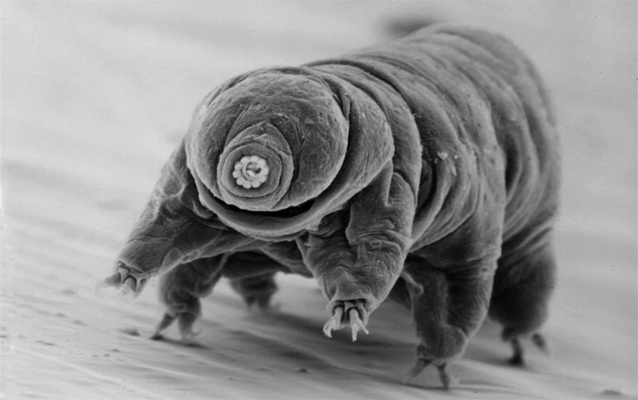This edition I am going to introduce you to the most badass living organism on Planet Earth. Some of you may assume it is humans, while others may think it is the honey badger – I’d have to disagree. Introducing to you: the water bear. A mere half a millimetre long, the water bear (also known as a tardigrade or moss piglet) may be tiny but it certainly makes up for its small stature with some mind-boggling badassery.
Water bears comprise an ancient family of organisms, with fossils found dating back 350 million years. Today, over 1,000 species of water bear can be found inhabiting mosses, lichens, freshwater and ocean sediments spanning a diverse range of environments. From 6,000 metres above sea level in the Himalayas to 4 kilometres beneath the ocean surface, water bears have found homes around the globe from polar regions to the tropics.
Water bears have been able to colonise so many different environments because they are extremophiles – they are organisms capable of living in conditions detrimental to most other life on Earth. For example, they can survive in temperatures ranging from absolute zero (that’s minus 273 degrees Celsius) to above the boiling point of water (more than 100 degrees Celsius). It’s not only extreme temperatures that water bears can withstand though; they can endure 1,000 times more radiation than humans and pressures up to six times greater than those found in the deepest waters of , the Marianas Trench.
The water bear’s hardiness is not confined to the realms of terrestrial Earth. These microorganisms have been flown into space, where experiments revealed that they can survive the vacuum of space and damaging cosmic rays for up to ten days. How long can humans last? A couple of minutes, max. So forget 2001: A Space Odyssey – if anything’s going to be an intergalactic traveller, it’ll be water bears!
Part of the reason these incredible pioneers of astrobiology could survive the harsh conditions of outer space is a clever trick called cryptobiosis. In cryptobiosis, water bears reversibly stop their metabolism and enter a state of dehydration in response to inhospitable conditions. With water content dropping to 1% of their normal levels, water bears can survive for up to 10 years in this suspended state, rehydrating and returning to normal when conditions become favourable again.
Understanding all the insanely cool stuff water bears can do might also have applications. For example, if we can figure out how they stay alive while dehydrated at room temperature, we could apply this knowledge to create stable vaccines that don’t have to be refrigerated – a costly requirement that makes them difficult to transport. Perhaps it could even lead to advances in cryopreservation.
I hope I’ve convinced you of the remarkable badassery of the water bear. All in all, these stumpy, eight-legged little guys just like to chill, no matter what the temperature, or whether they’re on Earth or in space. Water bears showcase the phenomenal survival skills Mother Nature can create, and remind us that the microscopic natural world can be fascinating too.
We acknowledge the Ngunnawal and Ngambri people, who are the Traditional Custodians of the land on which Woroni, Woroni Radio and Woroni TV are created, edited, published, printed and distributed. We pay our respects to Elders past and present. We acknowledge that the name Woroni was taken from the Wadi Wadi Nation without permission, and we are striving to do better for future reconciliation.
